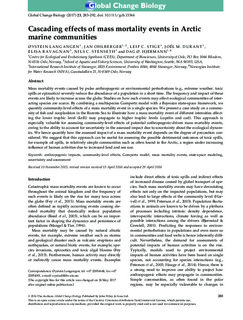| dc.contributor.author | Langangen, Øystein | |
| dc.contributor.author | Ohlberger, Jan | |
| dc.contributor.author | Stige, Leif C. | |
| dc.contributor.author | Durant, Joel M. | |
| dc.contributor.author | Ravagnan, Elisa | |
| dc.contributor.author | Stenseth, Nils C. | |
| dc.contributor.author | Hjermann, Dag Ø. | |
| dc.date.accessioned | 2018-04-18T13:46:49Z | |
| dc.date.available | 2018-04-18T13:46:49Z | |
| dc.date.created | 2016-08-22T13:30:10Z | |
| dc.date.issued | 2017 | |
| dc.identifier.citation | Global Change Biology. 2017, 23 (1), 283-292. | nb_NO |
| dc.identifier.issn | 1354-1013 | |
| dc.identifier.uri | http://hdl.handle.net/11250/2494877 | |
| dc.description.abstract | Mass mortality events caused by pulse anthropogenic or environmental perturbations (e.g., extreme weather, toxic spills or epizootics) severely reduce the abundance of a population in a short time. The frequency and impact of these events are likely to increase across the globe. Studies on how such events may affect ecological communities of inter-acting species are scarce. By combining a multispecies Gompertz model with a Bayesian state-space framework, we quantify community-level effects of a mass mortality event in a single species. We present a case study on a community of fish and zooplankton in the Barents Sea to illustrate how a mass mortality event of different intensities affecting the lower trophic level (krill) may propagate to higher trophic levels (capelin and cod). This approach is especially valuable for assessing community-level effects of potential anthropogenic-driven mass mortality events, owing to the ability to account for uncertainty in the assessed impact due to uncertainty about the ecological dynamics. We hence quantify how the assessed impact of a mass mortality event depends on the degree of precaution considered. We suggest that this approach can be useful for assessing the possible detrimental outcomes of toxic spills, for example oil spills, in relatively simple communities such as often found in the Arctic, a region under increasing influence of human activities due to increased land and sea use. | nb_NO |
| dc.language.iso | eng | nb_NO |
| dc.publisher | Wiley | nb_NO |
| dc.rights | Navngivelse-Ikkekommersiell 4.0 Internasjonal | * |
| dc.rights.uri | http://creativecommons.org/licenses/by-nc/4.0/deed.no | * |
| dc.title | Cascading effects of mass mortality events in Arctic marine communities | nb_NO |
| dc.type | Journal article | nb_NO |
| dc.type | Peer reviewed | nb_NO |
| dc.description.version | publishedVersion | nb_NO |
| dc.rights.holder | © 2016 The Authors | nb_NO |
| dc.source.pagenumber | 283-292 | nb_NO |
| dc.source.volume | 23 | nb_NO |
| dc.source.journal | Global Change Biology | nb_NO |
| dc.source.issue | 1 | nb_NO |
| dc.identifier.doi | 10.1111/gcb.13344 | |
| dc.identifier.cristin | 1374616 | |
| dc.relation.project | Norges forskningsråd: 179569 | nb_NO |
| cristin.unitcode | 7464,20,14,0 | |
| cristin.unitname | Marin biogeokjemi og oseanografi | |
| cristin.ispublished | true | |
| cristin.fulltext | original | |
| cristin.qualitycode | 2 | |

